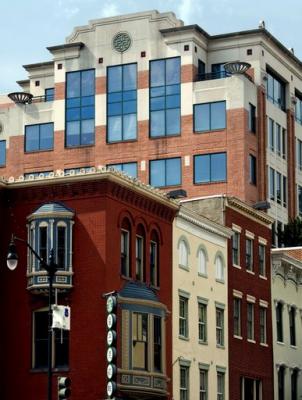
When the market recovers, smartly located urbanism will claim a larger share. Here's why.

Even before the recession began, the market for residential and commercial property in the US was changing away from a model of unmitigated suburban sprawl and toward one of more central locations, urbanity, and walkable neighborhoods. The foreclosure crisis, spike in gasoline prices, and then the full-blown recession have only placed the changes in the market in starker relief. I believe that we are unlikely to return to the old days of sprawl's utter and complete domination of the real estate map.
Among the evidence, there is a clear geography to the changes in real estate prices we are now seeing: close-in locations are now more highly valued than they used to be, and sprawling locations are less valued than they used to be. I reported this most recently in my map of changing home values in the Washington, DC, region, which shows steep declines in sprawling locations over the last year, but only modest ones (and, in one case, an increase in value) in inner locations.
This is consistent with various maps showing the patterns of foreclosure, such as those in Denver and Houston, which depict, sadly, many more foreclosures in sprawling new suburbs than in urban locations. Something similar has been happening with regard to commercial properties, too, even before the recession.
A second set of indicators that things are changing reflects the way that central cities (save some egregious cases like Detroit) have experienced a building boom and influx of new jobs and residents. Dr. John Thomas at EPA has been analyzing the geography of housing permits, and he has seen dramatic rises in the central-area share (and, conversely, drops in the outer-suburban share) of new housing construction over the last two decades.
Arthur C. (Chris) Nelson, now at the University of Utah, and a scholar who knows more about these things than anyone else I know, has examined homebuyer preference surveys. Nelson reports that fully three-fourths of Americans now prefer either attached housing (apartments, condos, townhouses) or homes on small lots of approximately one sixth of an acre or smaller. 25 percent express a preference for homes on larger lots above one sixth of an acre in size.
Simply put, this is no longer the same America that fled the cities in droves in the 20th century and created the new suburbs, one after another, that they hoped would be idyllic. One thinks of the classic suburban household as a couple with school-age kids. Readers of a certain age will recall the popular TV shows "Ozzie and Harriet" or "Leave It to Beaver" as the sitcom manifestations of suburban family life. In the 1960s, when those TV shows were popular, it made a certain amount of sense: 48 percent of American households, says Nelson, consisted of couples with kids in 1960.
But that's no longer the case. Today, the number is down to 33 percent, and by 2030, 72 percent of American households will consist of either single people living alone or couples without kids.
I wrote some time back that sprawl as we have known it may not be dead but it is surely not well, and we are already seeing the beginning of its end. I'll concede that's a lot to wish for, and we may not get there entirely. But there are too many patterns afloat that all point to the same conclusion: there can be little doubt that, when recovery finally comes, smart growth will reap the bigger rewards.
For more elaboration, including details and links, please see my home blog at NRDC, here.


Comments
Write your comments in the box below and share on your Facebook!